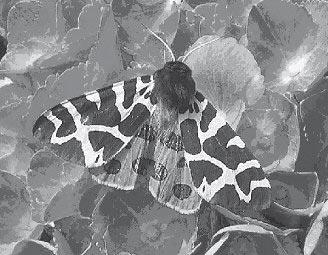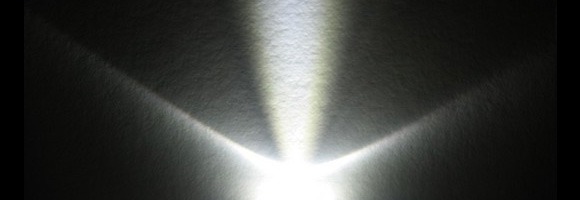Colin Henshaw and Graham Cliff believe that light pollution is reducing the numbers of insects on which many birds rely
In 1994, the Journal of the British Astronomical Association carried a letter from one of the authors (Colin Henshaw) entitled The Environmental Effectsof Light Pollution. The letter concluded by predicting that the anticipated reduction in the insect population caused by light pollution would affect predators higher up the food chain.
European light pollution at night circa 1998
Recent research has shown a reduction in the populations of moths, spiders, sparrows and amphibians, supporting the case for light pollution being considered a threat to the environment as well as to astronomers – who find the glare interfering with their observations – and householders – who complain of the visual intrusion caused by security lights and insensitive street lighting.
It is common knowledge that street and security lights attract insects: indeed, 2000-watt light traps are used by scientists to study insect species in the Brazilian rain forest. The authors think that the increasing numbers of urban street and security lights must have a measurable impact on the environment, as insects fly around the lights all night and eventually fall to the ground exhausted, no longer having the energy to feed themselves or to procreate. Consequently, with lights often left on all night, 365 nights a year, the number of insects must be significantly reduced.
“As a child, I was amazed by the profusion of insects to be seen in the countryside,” recalls Colin Henshaw. “But, returning home to Manchester, I noted there were fewer insects.” Considering the number of lights in an average city and the rate at which this number has grown in recent years, they must sweep up millions of insects every day. So it comes as no surprise to find that many urban and suburban environments are now increasingly sterile as far as insects are concerned. Insects are the primary food source for many predators (such as bats, birds, lizards and frogs), and their decline has a serious knock-on effect for other creatures.
House sparrows are declining: recent research show that their young rely on insects for food
The 1994 letter also pointed out that insects are important pollinators. If their numbers go down, thenso too will the number of successful flower pollinations, producing a vicious circle of decline in the biodiversity of plants. Two facts are worth noting: first, Dr Kelvin Conrad of the Rothamsted Research Centre hasremarked that Holland is the most sterile country in Europe; second, Dr P Cinzano of Padua University has produced satellite evidence that, in Europe, light pollution is at its worst in Holland.
In the mid 1990’s, Colin Henshaw’s father commented that he had not seen a thrush in the garden for ten years. Most people in Britain are aware of the decline in the number of house sparrows and that of many other previously common or ‘garden’ birds. Sparrows, and their hatchlings, had been presumed to be wholly granivorous but recent research by Dr. Kate Vincent has shown that hatchlings in fact feed on insects (or spiders) to obtain protein, so, if they do not get enough insects when young, they do not survive.
Spiders, too, feed on insects, so if the number of insects goes down, spider numbers will likewise decline. And a discussion of insects cannot overlook recent reports on the populations of British moths. For instance, the environmental group Butterfly Conservation has found a decline of a third in the larger moth species in Britain since 1968; some have been reduced by as much as 98%.
This decline in moths and sparrows has mirrored the expansion of street lighting in the UK, and elsewhere around the world. As more and more conurbations have leaked out more light into the environment, the effect on the insect population must have been devastating. One German study presented at a symposium in 2003 concluded that a single streetlight would kill, on average, 150 insects per night. Philipp Heck, president of Dark Sky Switzerland, has suggested that the 50,000 or so streetlights left on all night in Zürich kill over 1,000,000 insects per night.

The Garden Tiger Moth, one of the large moths
whose numbers are declining
Whether the loss of insects is a direct result of street lighting is yet to be proved conclusively. However, what is not speculative is the cost of light pollution in money and energy. One 500-watt security light on every night for a year is the source of more carbon dioxide emissions, in the electricity it consumes, than a typical fuel-efficient car being driven more than 8000km.
The current fashion for over-lighting our natural environment has many adverse consequences. Reducing light pollution would save money and energy, improve the environment for us all, and help to return our country’s biodiversity to a healthy level. The technology is available to turn off street and security lights when they are not needed: street-lighting trials in Denmark showed that the capital costs were recouped within a year from the energy savings.
Light pollution is a term used by astronomers to describe an effect that prevents us observing the night sky and, as such, it has come to be regarded as an issue of concern only to anoraks and nerds. However, as evidence from different branches of science comes together, it begins to seem as though the solution to one problem might also be the solution to others.
It seems, then, that the predictions of 1994 are now at last being vindicated. If we wish to see a reversal in the decline of some of our native species of animals, then we should do something to control the light pollution that appears to have had such a hidden, damaging, effect on them. If we are to reverse current trends, something needs to be done before it is too late. Whilst the idea of ‘Just In Time’ is well and good in industry, we do not want to see ‘Just Too Late’ in our environment, indeed for our world.
Colin Henshaw teaches in Dhaka, Bangladesh, and Graham Cliff was, until recently, an Analytical Electron Microscopist of Manchester University
The authors would like to thank Professor M E Bailey, Director of the Armagh Observatory for reviewing the text
Read More










